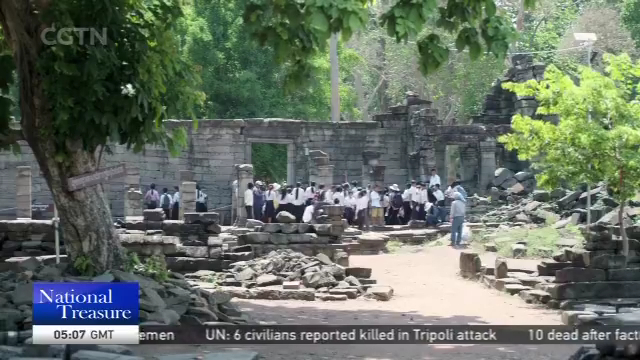
14:04, 17-May-2019
Cambodia's National Treasure: Angkor safeguarded for future generations
Updated
14:00, 20-May-2019
04:11

In its heyday, Angkor was the largest pre-industrial city on the planet, populated by almost a million people. It was mysteriously abandoned in the 15th century, but would later rise to prominence about 400 years later. Today, Angkor is a national treasure and a major tourist destination in Cambodia. CGTN's Miro Lu visited the famous ancient temple complex to see what local authorities are doing to ensure it doesn't fall off the map once again.
Deep in the forests of Cambodia's Siem Reap province, the elegant spires of an ancient stone city soar skyward above the sprawling complex of Angkor Archaeological Park.
SOK SANGVAR DEPUTY DIRECTOR GENERAL, APSARA AUTHORITY "Angkor, of course, presents a glorious past of our history. Angkor was the capital city of the Khmer Empire, that was established from the 8th to the 15th century. Angkor is today a world heritage site from UNESCO, so it is, of course, an international tourism destination."
MIRO LU SIEM REAP, CAMBODIA "Since the 1990s, Angkor Wat has become a major tourist destination. In 1993, when Cambodia first opened its door to the world, there were only about 7600 visitors to the site. That number reached 2.6 million last year. The influx of tourists has so far caused relatively little damage to the temple, but many question whether sustainable tourism can be achieved in Cambodia."
SOK SANGVAR DEPUTY DIRECTOR GENERAL, APSARA AUTHORITY "Apsara has been managing Angkor in a way that we give priority to the environment. So, for that, we do have programmes in terms of educating the stakeholders in the park. The sellers you see, when you enter, the tour guides, agents themselves and other stakeholders in the park to, really, first, not litter, I think the point is important, to understand also the impact of plastic, try to reduce."
Before the massive influx of tourists a few decades ago, plastic waste was not an issue in Cambodia. The surge in plastic waste in the Angkor area compelled a tourism industry-led initiative.
CHRISTIAN DE BOER CO-FOUNDER, REFILL NOT LANDFILL "With the recent increase of tourism, in Cambodia, which is a fantastic thing, it means more jobs, it means a better economy, it means more people being employed, unfortunately, there is also a downside and that means that Cambodia uses approximately 4.6 million plastic bottles every single month in Cambodia. Collectively, we hope to eliminate the use or abuse of plastic bottles in the tourism industry."
SOK SANGVAR DEPUTY DIRECTOR GENERAL, APSARA AUTHORITY "I think Angkor will always remain the soul of Cambodia where we all have a duty to preserve the authenticity of the site as being really the heart of Khmer culture."
CHANN PONITA STUDENT "For me, this temple is very important because our ancestors left it behind for us many thousands of years ago."
MIRO LU SIEM REAP, CAMBODIA "The future of the national treasure of Angkor Wat, as well as other ancient architectural wonders in Cambodia lies in the hands of the country's future generations. Heritage Watch, a Cambodian NGO, has been teaching children about the issues of destruction and pollution, and more importantly, making them proud of the cultural legacy they have been gifted."
UN MONINITA DIRECTOR, HERITAGE WATCH "When the community understands that this is their own property, they will love it and preserve it. It's their own responsibility because they are living with their cultural heritage every day."
If Cambodia can continue to balance its economic development with its cultural conservation and environmental awareness, the legacy of Angkor will last for many generations to come. Miro Lu, CGTN, Siem Reap, Cambodia.

SITEMAP
Copyright © 2018 CGTN. Beijing ICP prepared NO.16065310-3
Copyright © 2018 CGTN. Beijing ICP prepared NO.16065310-3